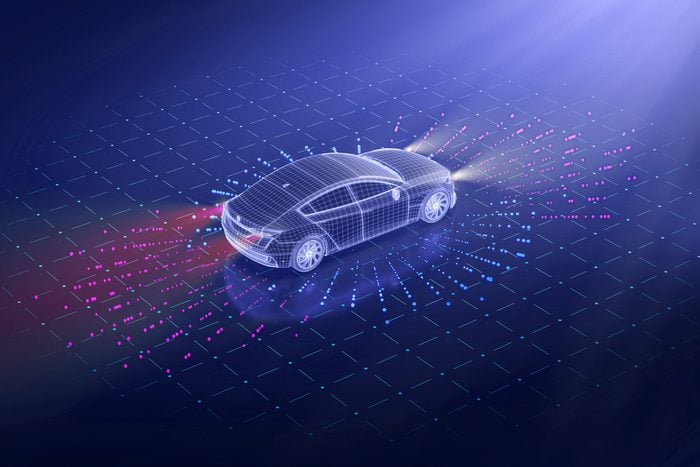How Self-Driving Cars Will Change the Roads
Updated: Feb. 01, 2024

When you think of self-driving cars, you probably imagine a vehicle that accelerates, steers and brakes without a human behind the wheel. But the scope of automated driving spans far beyond that. From the autopilot setting in Tesla cars to driverless pizza deliveries, a wide range of technology is considered “self-driving.”
In reality, what you are imagining is defined as a fully autonomous car, or a vehicle that can drive with zero human assistance. While companies like Google and Domino’s are already using autonomous cars in the commercial space, we are still several years away from finding fully autonomous vehicles for sale at car dealerships.
“After making big promises in the past, many companies have realized that building an autonomous vehicle [to sell to the public] was more difficult than they anticipated and have moved their timetables roughly a decade into the future,” according to Ronald Montoya, senior consumer advice editor at Edmunds.
A lot of progress has been made with driverless technology in the past few decades, but we still have a long way to go. We talked to the experts to find out what autonomous cars actually are, how they work, where they are legal and more. Curious about other tech that will shape the future? Learn the latest about real-life robots, AI and the metaverse next.
What are autonomous cars?
There are several levels of autonomous cars, according to the National Highway Traffic Safety Administration (NHTSA). The NHTSA defines a fully autonomous car as one that operates itself using sensors and cameras without any human assistance. Companies like Google’s Waymo have created fully autonomous cars, but those cars are not yet available for everyday drivers to purchase.
Fully autonomous cars shouldn’t be confused with advanced driver-assistance system (ADAS) technologies like cruise control or collision warnings, which are features of automated driving but still require a person to drive the vehicle. While the cars on today’s roads offer many high-tech safety features and are loosely called “self-driving,” they still require a person to keep their eyes on the road at all times. That means that none of them are fully autonomous vehicles by NHTSA’s standards.
“Every vehicle currently for sale in the United States requires the full attention of the driver at all times for safe operation,” says Lucia Sanchez, director of media relations at NHTSA. “While an increasing number of vehicles now offer some automated features designed to assist the driver under specific conditions, these vehicles are not fully automated.”
How do self-driving cars work?
Autonomous cars rely on a combination of sensors and cameras to detect and respond to their surroundings. The car’s radar sensors monitor the location of nearby vehicles, video cameras note traffic lights and road signs, and lidar and ultrasonic sensors use reflected light or sounds to identify curbs and lane markings. (Lidar sensors, by the way, work like radar but use light from a laser to measure distances.)
All these sensors pair up with powerful computer software that can operate the vehicle and react to obstacles or other vehicles on the road. In a fully autonomous car, the “system is fully responsible for driving tasks under all conditions and on all roadways. A human driver is not needed to operate the system,” per the NHTSA. Other self-driving cars may use similar technology, but they still need a human to sit behind the wheel and pay attention.
Even if you can’t drive an autonomous car right now, the best VR headsets can give you a taste of the future.
Is there a self-driving car now?
You won’t be able to purchase a fully autonomous car for at least another decade, Montoya says. But several self-driving car companies have already built autonomous vehicles, and some of those cars could be sharing the road with you today.
Waymo, an autonomous-driving tech company, and its parent company, Google, are widely considered the industry leaders when it comes to self-driving cars. Their first autonomous car hit the streets of Austin, Texas, in a test drive back in 2015. Since then, Google and Waymo have applied their driverless technology to an autonomous ride-hailing service and commercial trucking program.
In Houston, Domino’s has partnered up with the robotics company Nuro to launch a pilot program that delivers fresh-made pizzas via self-driving cars. All customers have to do is opt in to Nuro’s R2 delivery service, meet the car outside when it arrives and enter an access pin to unlock the door and get their pizza.
The next time you hail a Lyft, you might get the chance to experience the future of AI and driverless technology for yourself. But yes, you’ll still have a driver. “Right now, Lyft riders can request self-driving rides straight through their Lyft app in markets as diverse as Miami and Las Vegas,” says Jody Kelman, head of Lyft’s Autonomous division.
Lyft’s vehicles run in autonomous mode while safety operators sit in the driver’s seat to respond to emergency situations, according to Kelman. Not only are these rides tailored to customers’ travel preferences, including music and in-cabin temperature, but every self-driving Lyft car is also 100% electric, she says.
Where are self-driving cars legal?
Laws for self-driving cars vary by state, according to Montoya. Some states, such as Texas and California, allow a vehicle to be operated without a human, while others only allow testing of autonomous vehicles. Currently, 33 states and the District of Columbia allow either autonomous vehicle deployment or testing.
Since driverless cars are not for sale right now, these laws are really made for self-driving car companies that are testing products or commercial autonomous vehicles like Waymo or Nuro. Expect more laws, however, when self-driving cars become available to the public. Similarly, new laws will pop up in other futuristic endeavors, such as space tourism.
What is the future of self-driving vehicles?
Kelman predicts that many people’s first experiences with autonomous cars might be through ride-sharing services like Lyft. If customers can get comfortable with riding in self-driving cars with Lyft’s Autonomous program, they may be more likely to purchase an autonomous vehicle one day, she says.
Once driverless cars become more widely adopted, the future of cars without human drivers looks bright—and much safer. With nearly 40,000 people killed in motor vehicle crashes in 2020 alone, autonomous vehicles can prevent accidents caused by human error and driver fatigue or impairment, Sanchez says.
Self-driving cars could also increase vehicle occupancy and efficiency, as well as reduce traffic congestion, according to Kelman. “This means that [autonomous vehicles] can move more people more continually, reducing the space needed to park cars and improving city design,” she explains. Next, learn about the future of robots in the coming years.
Are self-driving cars safe?
While fully autonomous cars can offer plenty of benefits, the biggest hurdle they face is safety. That’s why the public rollout of autonomous cars is taking so long, experts say. “Many experts indicate that more work remains to be done by developers to ensure their safe operation before they are available for consumers to purchase,” according to Sanchez.
The sensors and cameras used by autonomous cars are not always reliable, especially under certain conditions. Right now, self-driving technology “can’t operate everywhere, under all weather conditions, at all times,” Kelman says. “For example, a sensor may not be able to see as well in fog or snow.”
There are also legal questions surrounding driverless cars. For one, lawmakers could someday need to decide who is responsible for accidents caused by autonomous cars. And although the government regulates self-driving cars for commercial use right now, it will likely need to create new regulations once fully autonomous cars are available to the public.
If you’re thinking about investing in a hybrid car in the meantime, beware: Hybrid cars have a major downside too, so you might want to consider one of these eco-friendly cars instead.
Sources:
- Ronald Montoya, senior consumer advice editor at Edmunds
- Lucia Sanchez, director of media relations at NHTSA
- Jody Kelman, head of Lyft Autonomous
- NHTSA: “Automated Vehicles for Safety”
- Waymo
- Domino’s: “Self-Driving Delivery”
- Governors Highway Safety Association: “State Laws”



